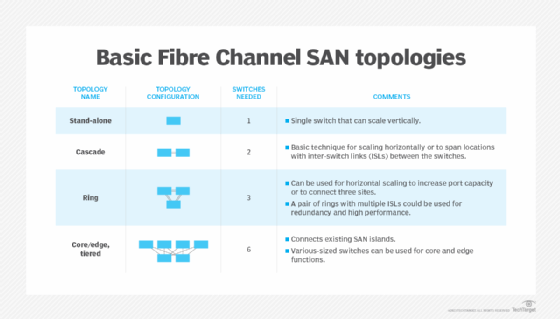What is a Fibre Channel switch (FC switch)? How it works, benefits and comparison to Ethernet switch
A Fibre Channel (FC) switch is a networking device that's compatible with the FC protocol and designed for use in a dedicated storage area network (SAN). FC switches direct and manage data traffic between servers and storage devices to facilitate high-speed data transfers and low-latency networking performance. These devices are highly suitable for data center environments that require fast data transfers for mission-critical workloads, online transaction processing (OLTP) databases and reliable disaster recovery.
How are Fibre Channel switches used?
FC switches connect computer data storage devices to servers and interconnect storage controllers and drives. These devices are typically added by SAN administrators as an organization's data center storage needs increase, particularly in terms of data transfer speeds and lossless data delivery.
FC switches are designed for applications that require high performance, low-latency data transfers and high availability (HA). These include data mining, data warehousing and business analytics applications, as well as server clusters, data backup systems and data/disaster recovery systems. Applications that use large databases or require high-performance storage also benefit from FC technology.
FC switches can be integrated with cloud storage solutions. These integrations enable organizations to create hybrid storage environments in which on-premises SANs are augmented with cloud storage to provide additional and high-speed storage that's more flexible, scalable, less burdensome to manage and cost-effective.
How a Fibre Channel switch works
Fibre Channel networks are based on a switched network topology that interconnects FC devices using FC switches.

FC supports point-to-point connections, where a server's FC host bus adapter is directly connected to a storage device, allowing the host to access the attached storage directly. Although a point-to-point architecture might be desirable in certain situations, the architecture doesn't scale well because every host requires a direct connection to any storage device that it could conceivably need to access.
An FC switch addresses this problem by acting as an intermediary between servers and storage. Servers are provided with a physical link to an FC switch rather than being attached directly to storage devices. Likewise, storage devices are also attached to the switch. When a server or host computer needs to access a storage device, the FC switch directs the request to the appropriate storage device.
The use of FC switches eliminates the need to directly connect every server to a SAN device. By connecting multiple SAN devices to the network instead, FC switches simplify the storage environment. Less complex storage is easier to manage and scale up (or down) as the organization's needs change.
Types of Fibre Channel switches
There are different types of FC switches, including modular director, fixed port and semi-modular.
Fixed-port FC switches include a set number of ports that cannot be added to. This can be a drawback for networks where scalability and flexibility are key considerations. On the other hand, if future growth is not a consideration, a fixed switch is less complex and cheaper.
Semi-modular FC switches are reliable and provide high-speed connectivity in the SAN. They are also scalable, making them suitable for growing networking environments. Some products include features like built-in analytics and telemetry capabilities, intelligent diagnostics tools, port-channel link members for additional HA, and enterprise-class features like virtual SAN (VSAN) identifiers and access control lists (ACLs).
Modular FC switches can be upgraded as data needs change. They offer greater scalability and flexibility than fixed-port and semi-modular switches, thus providing room for data center and SAN growth. Additionally, director-class FC switches can add capabilities, such as encryption and zoning, to disable unwanted traffic. Some products also provide inter-VSAN routing for resource sharing across VSANs, diagnostic and troubleshooting tools to verify connectivity and performance, and supervisor modules that automatically restart failed processes.
FC switches can be combined to create large SAN fabrics that interconnect thousands of servers and storage ports.
Benefits of a Fibre Channel switch
FC switches offer the following benefits:
- Don't require direct connections. FC switches reduce complexity because they don't require every server to have a dedicated connection to every SAN storage device.
- Greater transmission speed. In some cases, FC switches can provide greater bandwidth than a single FC connection. This is because FC switches can handle parallel traffic streams, so the total bandwidth provided by an FC switch is usually greater than what any one high-speed port can deliver.
- Support for quality of service. FC switches act as QoS components because they prioritize data traffic, ensuring that high-priority applications always receive the required bandwidth, even in high network congestion scenarios.
- Low latency networking. FC technology and switches minimize data transmission delays and lags, making them ideal for data centers running mission-critical applications, such as applications that require high-speed data storage or real-time (or near-real-time) interactions. Examples include banking, e-commerce, live streaming and online gaming.
- Ability to handle increasing data loads. FC switches support port aggregation, in which multiple physical network connections can be combined into a single logical link to easily handle increasing data loads. The switches also include traffic management features to optimize data flow and maintain high-performance networking.
- Suitable for extensive network environments. The range of FC switch connections can be as high as several kilometers, particularly when fiber optic cables are used. This makes them suitable for network environments that extend over long distances.
- Immune to electromagnetic interference (EMI). FC switches primarily use optical cables to connect servers and computers to SAN devices. This allows them to resist EMI and ensure reliable, high-performance, low-latency data transmission over longer distances.
- Suitable for virtual environments. FC switches are suitable for use in virtual environments where multiple virtual machines (VMs) handle heavy data loads and have very particular requirements regarding bandwidth and latency.
- OS-agnostic. FC switches can work with multiple operating systems, providing additional flexibility and high performance for different kinds of networking environments.
- Cloud integration. Integrating FC switches with cloud storage enables the creation of hybrid storage that offers enhanced flexibility, scalability, improved security, better disaster recovery and cost-effectiveness.
Drawbacks of Fibre Channel switches
One key drawback of FC switches is their cost. FC switches can be expensive, especially compared to Ethernet switches. Also, specialized hardware -- including fiber optic cabling -- is required to configure and manage the FC network and to capture all the benefits of lossless networking.
Another challenge is that the FC protocol is inherently more complex than other storage network protocols like Ethernet. Personnel with specialized skills are needed to understand the protocol, implement it correctly and manage it.
Fibre Channel switches vs. Ethernet switches
Ethernet and FC switches differ in many ways.
While FC switches are primarily used for SANs, Ethernet switches are mostly used in local area networks. In addition, Ethernet networks can be used for general-purpose network communications -- such as for PCs, tablets and internet of things devices (IoT devices) -- while FC switches are used only for connecting servers to storage arrays. FC switches are not used for general-purpose networking applications. Also, FC devices do not require an IP address to send and receive data.
Another important difference is that FC is a lossless protocol, compared to an Ethernet network, where packet loss is possible. FC also ensures that packets arrive in the order in which they were transmitted, whereas Ethernet networks allow packets to arrive in a different order from the way they were transmitted.
Compare Fibre Channel and Internet Small Computer System Interface in terms of SAN performance, ease of use, manageability, overall package and total cost of ownership.





